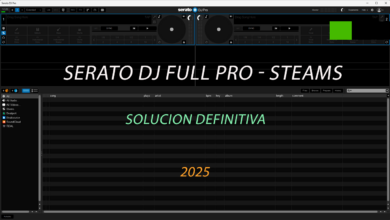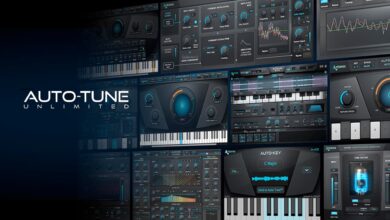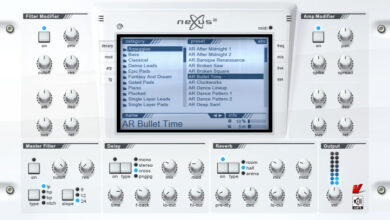Native Instrument – Traktor Pro 4 Full
Native Instrument – Traktor Pro 4

Native Instruments Traktor Pro 4 is the leading professional DJ software, designed for DJs seeking a fast workflow, advanced mixing tools, and seamless integration with hardware controllers such as the Traktor Kontrol S4/S8, X1, Z1, and others.
🔥 Key Features of Traktor Pro 4
✅ Audio Engine Improvements – Better stability and ultra-low latency.
✅ New Effects – Includes Reverb Freeze, Delay T3, and enhancements to classic effects (Flanger, Phaser, etc.).
✅ Stems Mode – Allows real-time mixing of tracks separated into four stems (bass, percussion, vocals, melody).
✅ Smart Playlists & Tagging – Intelligent organization of your music library.
✅ Hardware Integration – Optimized compatibility with NI controllers (Traktor Kontrol S4 Mk3, S3, etc.) and custom mapping.
✅ Recording & Streaming – Options for recording sets and live streaming.
✅ Timecode Vinyl/CD – Support for analog control with vinyl or CDs.
🎛 What’s Included in Traktor Pro 4? (vs. Previous Versions)
-
New effects and Stems mode (exclusive to v4).
-
Improved library management (Smart Playlists, tags).
-
Support for updated macOS and Windows versions.
-
More stable and optimized for live DJing.
💡 Who Is It For?
-
Professional DJs who need robust software.
-
Digital DJs using NI controllers or timecode.
-
Producer/DJs looking to experiment with Stems.
System Requirements for Native Instruments Traktor Pro 4 (Windows & macOS)
To ensure optimal performance, make sure your system meets the following requirements:
🖥️ Minimum Requirements
Windows
-
Operating System: Windows 10 (64-bit) or Windows 11
-
Processor: Intel Core i5 (4th generation or later) / equivalent AMD
-
RAM: 4 GB (8 GB recommended for Stems and multiple decks)
-
Disk Space: 2 GB for installation + space for libraries
-
Sound Card: ASIO-compatible (recommended for low latency)
-
Screen Resolution: 1366×768 (minimum)
macOS
-
Operating System: macOS 11 (Big Sur) or later
-
Processor: Intel Core i5 / Apple Silicon (natively compatible with M1/M2)
-
RAM: 4 GB (8 GB recommended for better performance)
-
Disk Space: 2 GB + space for music
-
Screen Resolution: 1280×800 (minimum)
🚀 Recommended Requirements (for the Best Experience)
-
Processor: Intel Core i7 / AMD Ryzen 7 or Apple M1/M2
-
RAM: 8 GB or more (especially when using Stems or multiple effects)
-
SSD (for fast track loading)
-
External audio interface (with ASIO drivers on Windows)
-
Traktor controller (S4, S3, etc.) or custom MIDI mapping
contraseña: remixeslima.com
What is a Cryptocurrency and How Does It Work?
A cryptocurrency is a type of digital currency that uses cryptography for security and operates on a decentralized network called blockchain. Unlike traditional money (like the US dollar or euro), cryptocurrencies are not controlled by banks or governments—they rely on a peer-to-peer system.
 Key Features of Cryptocurrencies
Key Features of Cryptocurrencies
-
Decentralization: No central authority (like a bank) controls them.
-
Security: Transactions are secured by blockchain technology (tamper-proof records).
-
Pseudonymity: Transactions are public, but identities are hidden behind wallet addresses.
-
Limited Supply: Many cryptos have a max supply (e.g., Bitcoin’s 21 million cap).
-
Borderless: Can be sent globally without intermediaries.
 How Do Cryptocurrencies Work?
How Do Cryptocurrencies Work?
1. Blockchain Technology
-
A distributed ledger maintained by thousands of computers (nodes).
-
Transactions are grouped into blocks and added to the chain after validation.
-
Once recorded, transactions cannot be altered (immutability).
2. Transactions
-
If Alice sends 1 Bitcoin to Bob, the transaction is broadcast to the network.
-
Miners (in Bitcoin) or validators (in Ethereum 2.0) verify the transaction.
-
Once confirmed, it’s added to the blockchain (time varies by network).
3. Mining & Staking
-
Mining (Proof of Work – PoW): Used by Bitcoin. Miners solve complex math problems to validate transactions and earn crypto rewards.
-
Staking (Proof of Stake – PoS): Used by Ethereum 2.0, Cardano. Users “lock up” coins to validate transactions and earn interest.
4. Wallets
-
Hot Wallets: Connected to the internet (e.g., MetaMask, Trust Wallet).
-
Cold Wallets: Offline storage (e.g., Ledger, Trezor) → More secure.
-
Each wallet has a private key (like a password) and a public address (like an account number).
 Types of Cryptocurrencies
Types of Cryptocurrencies
-
Bitcoin (BTC): The first and most famous (“digital gold”).
-
Ethereum (ETH): Supports smart contracts & decentralized apps (DeFi, NFTs).
-
Stablecoins: Pegged to fiat (e.g., USDT = $1).
-
Altcoins: Other cryptos like Solana (SOL), Cardano (ADA).
-
Utility Tokens: Used in specific ecosystems (e.g., BNB for Binance Chain).
 How to Get Cryptocurrencies?
How to Get Cryptocurrencies?
-
Buy on exchanges (Binance, Coinbase, Kraken).
-
Mine (requires powerful hardware).
-
Stake (earn passive income by locking coins).
-
Airdrops & Rewards (some projects give free tokens).





